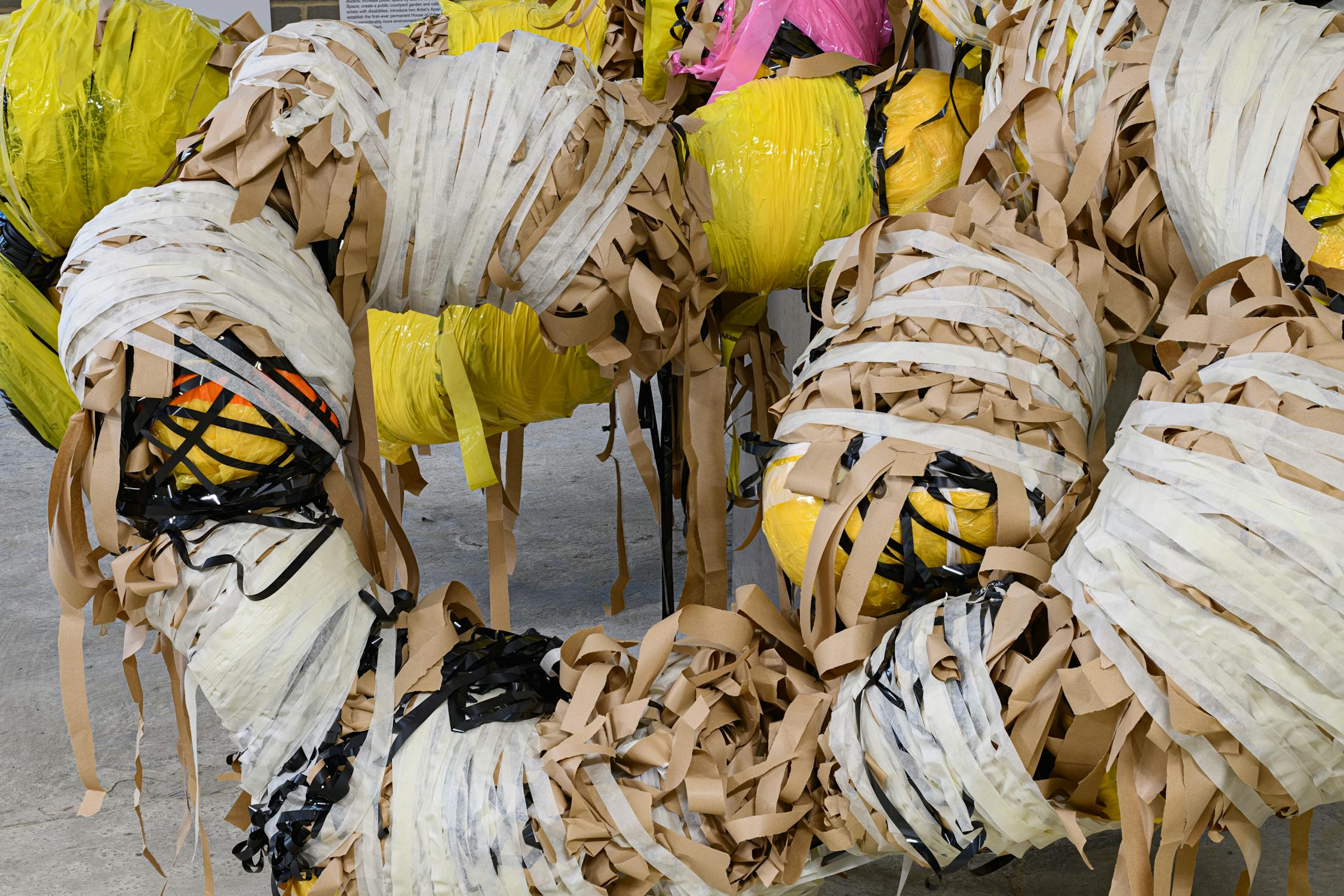Nnena Kalu (b. 1966, Glasgow) lives and works in London and is an important member of both Studio Voltaire and ActionSpace’s artistic communities. Recent exhibitions include: Nnena Kalu: Wrapping, Humber Street Gallery, Hull (2019); TUBE LINES, Tate Exchange, Tate Modern, London (2019); Spectrum Arts Prize, Saatchi Gallery, London (2018); Glasgow International, Project Ability, Glasgow (2018); Spring Syllabus, J Hammond Projects, London (2018); Watch This Space, Wandsworth Arts Fringe, London (2017); Radical Craft: Alternative Ways of Making, Pallant House Gallery, Chichester (2017); Capharnaum, Theatre de Liege, Le Madmusee, Liege (2016); Studio Voltaire OPEN, Selected by Cory Arcangel and Hanne Mugaas, Studio Voltaire, London (2015); Dizziness of Freedom, Bermondsey Project, London (2014); The Trouble with Painting Today, Pump House Gallery, London (2014); Epiphanies! Secrets of Outsider Art, St Pancras Hospital, London (2014); Side by Side, Southbank Centre, London (2013); SV12 Member’s Show, Selected by Jenni Lomax and Mike Nelson, Studio Voltaire, London (2012).

Alice Channer on Nnena Kalu
July 2020
Read below Alice Channer's sculptural and poetic text in response to Nnena Kalu's 2020 offsite commission, as part of Studio Voltaire elsewhere, at Old Burlington Street in Mayfair.
During this exhibition, periods of live installation came to form an established aspect of Kalu’s practice. Correspondingly, for this new commission Kalu periodically worked in situ at the gallery during the exhibition. Over time, Kalu continued to add to the dense clusters and layers of her sculptures. Continuously in production, her works reflect the duration, rhythm and process of their making, transforming and accentuating the formal qualities of her everyday materials.
–
Nnena Kalu’s sculptures at Studio Voltaire elsewhere had an appetite. They consumed Kalu’s materials and excreted them as sculptural energy, manifesting in multiple fizzing directions but especially h o r i z o n t a l l y. It made sense, then, to hear that hanging boulders from another recent solo exhibition at Humber Street Gallery had been eaten (alive? dead? neither? both?) by these voracious new forms. These 3 works were thrillingly apocalyptic – full of potential and possibility, with no hierarchy and continual renegotiation of every condition they appeared to set for themselves.
The skeletons on and with which Kalu’s tape accreted remained visible. The wooden and plastic bones the tape both fleshed out and flaked off were sometimes revealed, complicating the hierarchy between support and body. These bones both held their flaking flesh up and were exceeded by it as it pushed out beyond them. The slight glamour in the shine of the many-coloured plastic tape, and the lightness and vulnerability of the paper tape added fine detail and intimacy to what from a distance resolved as chaotic and boisterous forms. From some angles, parts of Kalu’s sculptures appeared pleasingly plump, like ramshackle, artificial chrysalises. This was skilfully contradicted by ecstatic, abject surfaces. These surfaces were contingent and consisted of insides spillling out and continuously erupting. In these works, there was no hierarchy between exterior surface and interior content.
The heavy, literal form of the boulder, undercut by the antigravity of the materials (explicitly artificial packing and wrapping tape) that constituted it, recalled fellow monumental sculptor Phyllida Barlow. But Kalu’s forms, materials and process are unencumbered by the crustiness and authenticity that sometimes gives extra weight and baggage to a Barlow sculpture.
Displayed within the gallery were boxes of Kalu’s tape, and dispensers and structures to hold it. The artist wasn’t present working on/with/as her works-in-process on the day I visited, but the presence of these materials in the exhibition emphasised the importance of process to these works. It’s interesting to consider this in relation to a historical minimalist process artist like Robert Morris, whose liberating quote ‘there are forms to be found within the activity of making as much as within the end products’ rings true also for Kalu’s work. Her work also bears comparison to the ecstatic abjection of Linda Benglis, but Kalu’s forms seem wilder, more likely to succumb to either antigravity or to gravity than, for example, a Benglis pour piece.
Kalu’s work builds on that of these canonical sculptors because it does not fetishise the body (of the artist) that is doing the making. Morris especially refers back continually to the essentialized and normative body (his) making the work. In contrast, Kalu’s forms appear to be unmaking and making themselves autonomously, through repetition and accretion. Their success is in joyfully, awkwardly manifesting their process of becoming whilst succeeding as resolved forms in their own right.
—Alice Channer, July 2020
Alice Channer (born 1977) is a British sculptor based in London. Known for her sculptures and mixed media works that explore our relationship to objects, Channer uses materials ranging from metal and concrete to textiles and paper. Selected solo institutional exhibitions include R o c k f a l l, Aspen Art Museum, Aspen, USA (2015), Pool, Kestnergesellschaft, DE (2014), Invertebrates, Hepworth Wakefield, UK (2013), Soft Shell, Kunstverein Freiburg, DE (2013), Out Of Body, South London Gallery, London, UK (2012). In 2021, she made her first permanent public sculpture commission, Nanowires, for the new Engineering Department Building at the University of the West of England, and Lethality and Vulnerability, a major new site-responsive commission for Artangel (UK).